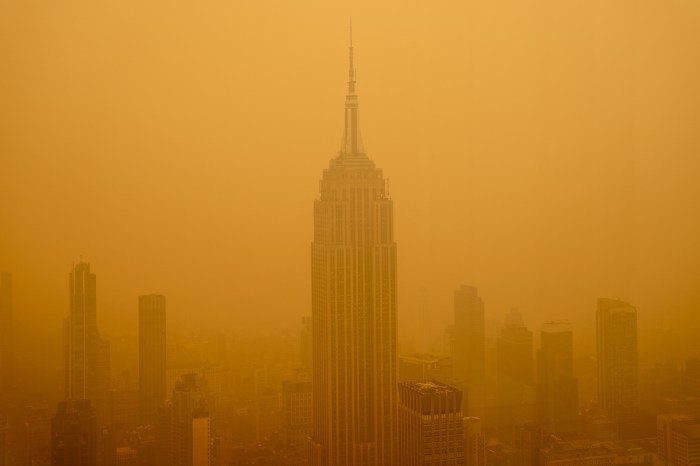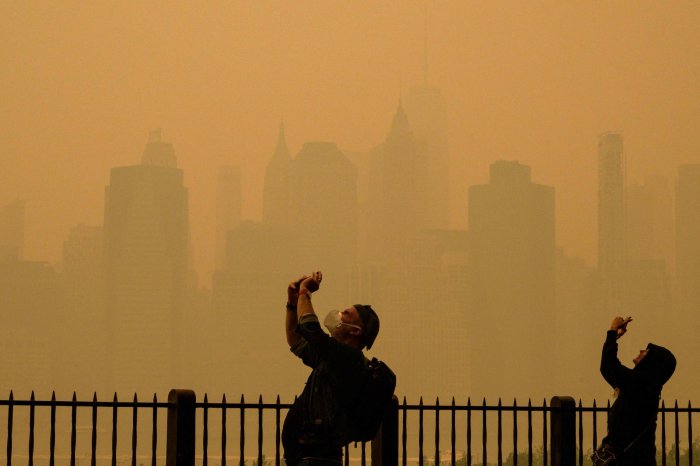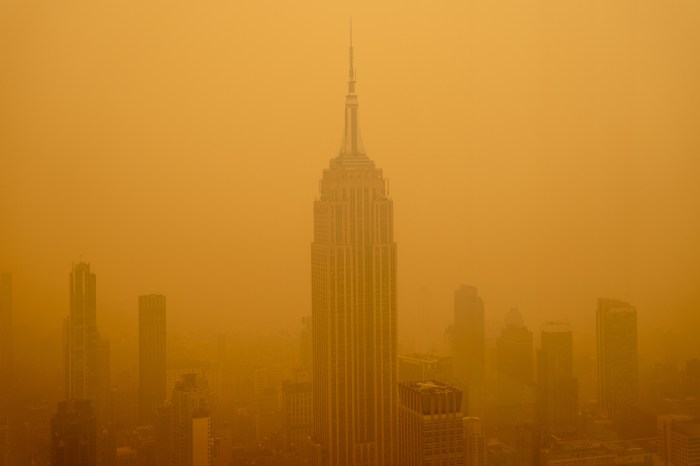
New York Chokes on Unprecedented Smog Crisis as Global Air Pollution Worsens
New york chokes on unprecedented smog crisis as global air pollution worsens – New York City, a metropolis renowned for its towering skyscrapers and bustling streets, is currently grappling with an unprecedented smog crisis. This crisis, a stark reminder of the escalating global air pollution problem, has cast a dark shadow over the city, prompting concerns about public health, economic implications, and the long-term environmental consequences.
The smog crisis has reached alarming levels, with pollutants like particulate matter and ozone exceeding safe limits. These pollutants, primarily emanating from vehicle emissions, industrial activities, and power plants, are wreaking havoc on the city’s air quality. The situation is further exacerbated by meteorological conditions such as temperature inversions and stagnant air, which trap pollutants and intensify the smog.
New York’s Smog Crisis

The current smog crisis engulfing New York City is a stark reminder of the vulnerability of our urban environments to air pollution. The city is currently experiencing a severe episode of smog, with air quality reaching hazardous levels. This crisis has raised concerns about the long-term impact on public health and the need for immediate action to address the root causes of air pollution.
The Severity of the Smog Crisis
The smog crisis has reached unprecedented levels, with the air quality index (AQI) exceeding 200 in many parts of the city. This means that the air is considered hazardous for all individuals, particularly vulnerable groups such as children, the elderly, and people with respiratory illnesses.
The primary pollutants contributing to the smog are particulate matter (PM2.5), ozone (O3), and nitrogen dioxide (NO2). These pollutants can penetrate deep into the lungs and cause a range of health problems, including respiratory infections, heart disease, and even cancer.
Comparison to Historical Events
The current smog crisis is reminiscent of the Great Smog of London in 1952, which killed thousands of people. However, there are also significant differences. The London smog was primarily caused by coal burning, while the current smog in New York City is a result of a complex mix of factors, including vehicle emissions, industrial activity, and wildfires.
While the current crisis is not as severe as the London smog, it is still a cause for concern, especially given the long-term health effects of air pollution.
It’s hard to imagine a world where the air we breathe is a constant threat, but that’s the reality we’re facing. New York’s unprecedented smog crisis is a stark reminder of the global air pollution crisis. While the city grapples with this challenge, it’s also worth noting that some individuals are choosing to exploit others for personal gain, like the father and son in Massachusetts who recently received prison sentences for a $20 million lottery scam, as reported in this article.
These events highlight the need for collective action, both in addressing environmental challenges and holding those who commit fraud accountable.
The Role of Climate Change
Climate change is exacerbating the smog crisis in New York City. Extreme weather events, such as heat waves and droughts, can increase the formation of ozone and other pollutants. For example, the current heat wave has led to an increase in vehicle emissions and has created stagnant air conditions that trap pollutants.
Additionally, climate change is leading to an increase in wildfires, which release large amounts of smoke and particulate matter into the atmosphere. These factors are all contributing to the severity of the current smog crisis.
Causes of the Smog Crisis
The unprecedented smog crisis engulfing New York City is a complex issue with multiple contributing factors. The primary culprits are human activities that release pollutants into the air, exacerbated by meteorological conditions that trap these pollutants, leading to the formation of smog.
The dense population and urban sprawl of New York City also contribute to the severity of the crisis.
It’s unsettling to see New York City choked by smog, a stark reminder of the global air pollution crisis we’re facing. This environmental catastrophe mirrors the economic struggles many nations are enduring, like Pakistan, which is grappling with its own set of challenges.
A recent article, pakistans economic crisis analyzing challenges and charting a path to financial stability , dives into the complex issues hindering Pakistan’s economic growth. Just as we strive for cleaner air in New York, we need global solutions to address both environmental and economic crises, ensuring a sustainable future for all.
Industrial Emissions
Industrial activities are significant contributors to air pollution in New York City. Many industries, particularly those involved in manufacturing, power generation, and chemical processing, release harmful pollutants into the atmosphere. These pollutants include particulate matter, sulfur dioxide, nitrogen oxides, and volatile organic compounds (VOCs).
For instance, power plants burning fossil fuels release large amounts of sulfur dioxide and nitrogen oxides, which contribute to acid rain and respiratory problems. The chemical industry also emits VOCs, which react with other pollutants to form ground-level ozone, a major component of smog.
Transportation Emissions
Transportation is another major source of air pollution in New York City. The city’s extensive network of roads and highways is heavily congested, leading to high levels of vehicle emissions. Cars, trucks, buses, and other vehicles release pollutants such as carbon monoxide, nitrogen oxides, and particulate matter.
Diesel engines, particularly those used in heavy-duty trucks, are known to emit high levels of particulate matter, which can penetrate deep into the lungs and cause respiratory problems. The city’s reliance on private vehicles, coupled with limited public transportation options, further exacerbates the issue.
Meteorological Conditions
Meteorological conditions play a crucial role in trapping pollutants and intensifying smog episodes. Stable atmospheric conditions, such as temperature inversions, can prevent pollutants from dispersing, leading to their accumulation in the lower atmosphere. A temperature inversion occurs when a layer of warm air sits above a layer of cold air, creating a barrier that prevents vertical mixing.
This trapping effect allows pollutants to build up, leading to high levels of smog. Additionally, calm wind conditions can also contribute to the formation of smog by limiting the dispersal of pollutants.
Population Density and Urban Sprawl
New York City’s high population density and urban sprawl create unique challenges for managing air pollution. The city’s densely packed neighborhoods and towering buildings trap pollutants, limiting their dispersal. Urban sprawl, characterized by the outward expansion of cities, further exacerbates the problem by increasing the distance pollutants must travel to reach cleaner air.
The combination of high population density and urban sprawl creates a perfect storm for air pollution, making it challenging to effectively manage the problem.
Impacts of the Smog Crisis
The unprecedented smog crisis engulfing New York City has far-reaching consequences, impacting the health of its residents, the city’s economy, and the environment. The smog’s impact on human health is immediate and significant, with potential long-term consequences. The economic repercussions are equally alarming, with the potential to disrupt businesses and industries, and strain healthcare systems.
It’s a sobering reality that New York City, a symbol of urban life, is grappling with an unprecedented smog crisis, a stark reminder of the worsening global air pollution. This crisis makes you wonder if perhaps the city’s allure is fading, especially when you consider new research revealing the surprising No.
1 city for remote jobs, defying New York and San Francisco
Moreover, the environmental impacts of this crisis extend beyond the city’s boundaries, contributing to broader issues of climate change and ecosystem degradation.
Health Impacts
The smog crisis poses a serious threat to the health of New Yorkers, particularly those with pre-existing respiratory and cardiovascular conditions. The fine particulate matter (PM2.5) and other pollutants in the smog can easily penetrate deep into the lungs, causing a range of respiratory problems.
- Respiratory Issues:Smog can trigger asthma attacks, worsen chronic obstructive pulmonary disease (COPD), and increase the risk of bronchitis and pneumonia. Studies have shown a direct correlation between air pollution and increased hospital admissions for respiratory illnesses.
- Cardiovascular Problems:The pollutants in smog can also damage blood vessels, leading to increased blood pressure, heart attacks, and strokes. The elderly and people with heart conditions are particularly vulnerable to these effects.
- Other Health Risks:Exposure to smog has been linked to other health problems, including eye irritation, skin problems, and even cancer.
Economic Impacts
The smog crisis is not only a health hazard but also a significant economic burden on New York City. The reduced air quality can lead to lost productivity, increased healthcare costs, and disruptions to businesses and industries.
- Lost Productivity:Smog can cause respiratory problems and fatigue, leading to decreased productivity in the workforce. Businesses may experience absenteeism and reduced efficiency due to employees’ health issues.
- Healthcare Costs:The increased incidence of respiratory and cardiovascular problems due to smog leads to higher healthcare costs. Hospital admissions, emergency room visits, and long-term care expenses are likely to rise.
- Business Disruptions:The smog crisis can also disrupt businesses and industries. For example, construction projects may be delayed due to poor air quality, and outdoor events may be canceled. The tourism industry could also be affected, as visitors may be hesitant to travel to a city with severe smog.
Environmental Impacts
The smog crisis is not just a local problem; it has far-reaching environmental consequences. The pollutants released into the atmosphere contribute to climate change, acid rain, and ecosystem degradation.
- Climate Change:Smog contains greenhouse gases like carbon dioxide and methane, which trap heat in the atmosphere and contribute to global warming. The smog crisis exacerbates climate change, leading to more extreme weather events, rising sea levels, and melting glaciers.
- Acid Rain:The sulfur dioxide and nitrogen oxides released from burning fossil fuels react with water vapor in the atmosphere to form sulfuric and nitric acids, which fall to the ground as acid rain. Acid rain can damage forests, lakes, and other ecosystems.
- Ecosystem Degradation:Smog can damage plants and animals, reducing biodiversity and disrupting food webs. The pollutants can also contaminate water sources, making them unsafe for drinking and harming aquatic life.
Responses to the Smog Crisis: New York Chokes On Unprecedented Smog Crisis As Global Air Pollution Worsens
The unprecedented smog crisis in New York City has prompted a multifaceted response from city and state governments, encompassing emergency measures, long-term policy shifts, and public health advisories. These efforts aim to alleviate the immediate health risks posed by the smog and to address the underlying causes of air pollution in the long term.
Emergency Measures
The city and state governments implemented a series of emergency measures to address the immediate health risks posed by the smog crisis. These measures included:
- Issuing air quality alerts and health advisories, urging residents to limit outdoor activities and stay indoors when possible.
- Activating emergency response protocols, including deploying mobile air quality monitoring stations and increasing the availability of emergency medical services.
- Temporarily restricting traffic in certain areas to reduce vehicle emissions.
- Providing free public transportation to encourage people to avoid driving.
Long-Term Policies
Recognizing the need for sustainable solutions, the government has introduced a range of long-term policies aimed at reducing air pollution and mitigating the impacts of future smog crises. These policies include:
- Investing in renewable energy sources, such as solar and wind power, to reduce reliance on fossil fuels.
- Implementing stricter emission standards for vehicles and industrial facilities.
- Promoting energy efficiency measures in buildings and homes.
- Encouraging the use of electric vehicles and public transportation.
- Expanding green spaces and urban forests to improve air quality.
Public Awareness and Individual Actions
Public awareness plays a crucial role in mitigating the smog crisis. The government has launched public awareness campaigns to educate residents about the health risks of air pollution and encourage them to adopt sustainable practices. These campaigns emphasize the importance of:
- Reducing vehicle emissions by carpooling, using public transportation, or cycling.
- Conserving energy at home by using energy-efficient appliances and reducing electricity consumption.
- Supporting businesses and organizations committed to environmental sustainability.
- Advocating for stronger environmental regulations and policies.
Effectiveness of Responses
The effectiveness of the government’s response to the smog crisis is still being evaluated. While emergency measures have helped to mitigate the immediate health risks, the long-term impacts of these policies remain to be seen. The effectiveness of public awareness campaigns is also a subject of ongoing research.
However, preliminary data suggests that these campaigns have raised public awareness about the issue of air pollution and have encouraged some individuals to adopt more sustainable practices. Despite these efforts, challenges remain in addressing the smog crisis. These challenges include:
- The need for greater investment in infrastructure and technology to support renewable energy sources and reduce emissions.
- The need for stronger enforcement of environmental regulations and policies.
- The need for continued public education and awareness campaigns to encourage sustainable practices.
Global Implications of Air Pollution

Air pollution is a global problem with far-reaching consequences, impacting not only individual health but also the environment and the global economy. While developed nations have made strides in improving air quality, the issue is becoming increasingly pressing in developing countries, where rapid industrialization and urbanization are leading to a surge in air pollution.
This section explores the global trends in air pollution, the interconnectedness of air pollution across borders, and the potential for international cooperation to address this challenge.
Global Trends in Air Pollution, New york chokes on unprecedented smog crisis as global air pollution worsens
Air pollution is a growing concern globally, with significant variations in its levels and sources across different regions. The World Health Organization (WHO) estimates that over 99% of the world’s population breathes air that exceeds its air quality guidelines.
- Developing countries, particularly in Asia and Africa, are experiencing a rapid rise in air pollution due to factors such as industrialization, increased vehicle ownership, and reliance on coal-fired power plants. This is leading to a significant health burden, with millions of premature deaths annually attributed to air pollution in these regions.
- While developed countries have made progress in reducing air pollution, challenges remain, especially in urban areas. Traffic congestion, industrial emissions, and seasonal factors contribute to persistent air pollution in many cities around the world.
Interconnectedness of Air Pollution
Air pollution does not respect national boundaries. Pollutants can travel long distances, transported by wind currents and atmospheric circulation patterns. This means that air quality in one region can be influenced by pollution sources in other countries.
- For instance, air pollution from industrial activities in China can be transported to South Korea and Japan, contributing to poor air quality in these countries.
- Similarly, transboundary air pollution from Europe and North America can impact air quality in the Arctic, contributing to the melting of glaciers and ice caps.
International Cooperation and Policy Coordination
Addressing global air pollution requires international cooperation and coordinated policy efforts. Recognizing the interconnectedness of air pollution, several international agreements and initiatives have been established to promote cleaner air and reduce transboundary pollution.
- The United Nations Framework Convention on Climate Change (UNFCCC) recognizes the role of air pollution in climate change and promotes measures to reduce greenhouse gas emissions, many of which also contribute to air pollution.
- The Convention on Long-Range Transboundary Air Pollution (CLRTAP) focuses on reducing air pollution that travels across national borders, particularly in Europe. It has implemented several protocols to control emissions of sulfur dioxide, nitrogen oxides, and other pollutants.
- The World Health Organization (WHO) provides guidance on air quality standards and promotes collaborative efforts to improve air quality globally.

